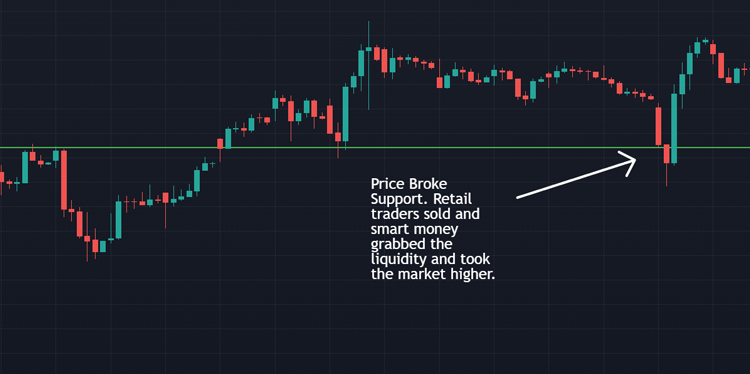Ever wondered why your trades don’t work out despite following all the classic trading rules? Maybe you’ve drawn perfect support and resistance lines or spotted a textbook candlestick pattern, yet the market seems to move against you. If this sounds familiar, it’s time to dive into smart money concept trading. This approach can transform how you navigate today’s fast-paced markets. In this guide, we’ll break down what smart money is, how it operates, and why understanding it is the key to profitable trading. Ready to trade smarter? Let’s get started!
Table of Contents
What Is Smart Money Concept Trading?
The market isn’t what it used to be. A decade ago, simple tools like support and resistance levels, trend lines, or candlestick patterns were enough to make consistent profits. But today? The market has evolved. It’s sharper, faster, and driven by smart money. So, what exactly is smart money concept trading? It’s a strategy that aligns your trades with the moves of big players—think institutional investors, banks, or those with deep pockets who trade massive quantities.
Unlike retail traders (like most of us) who trade smaller amounts, smart money players move the market in ways that can trap the unprepared. By understanding their tactics, you can avoid losses and ride the wave of their strategies for better profits.
Retail Traders vs. Smart Money: The Key Difference
Let’s paint a picture. You’re a retail trader, placing trades with a few hundred or thousand units, relying on familiar tools like chart patterns or moving averages. On the other side are the smart money players—big institutions or wealthy investors trading lakhs or crores worth of units. Their trades are so large they can shift the market’s direction.
- Retail Traders: Use basic tools like support, resistance, or trend lines. They often trade emotionally or follow outdated strategies.
- Smart Money: Includes banks, FIIs, DIIs, or high-net-worth individuals. They trade strategically, targeting areas where retail traders are most vulnerable.
Why does this matter? Because the market is a zero-sum game. For someone to profit, someone else has to lose. And smart money ensures it’s not them.
Why Traditional Strategies Are Failing
Remember the last time you saw a perfect breakout on a chart, placed a trade, and then watched the market reverse? That’s no coincidence. Today’s markets are smarter. Relying only on traditional tools like candlestick patterns or trend lines often leads to losses. Why? Because smart money manipulates these patterns to trap retail traders.
Combining these classic methods with smart money concept trading is the way forward. It’s like upgrading from a bicycle to a sports car—you’re still moving, but now you’re in sync with the market’s real drivers.
Understanding Liquidity: The Heart of Smart Money
Here’s a term you need to know: liquidity. In trading, liquidity refers to the stop losses placed by buyers and sellers. Smart money hunts these stop losses like a predator. They move the market toward areas with high concentrations of stop losses, regardless of whether they’re from buyers or sellers. Why? Because triggering these stop losses gives them the liquidity they need to make huge profits.
Think about it. When you set a stop loss, you’re telling the market where you’ll exit if things go wrong. Smart money sees this and pushes the price to hit those levels, cashing in on your loss. Sounds unfair? It’s just how the game works.
How Smart Money Traps Retail Traders
Smart money doesn’t just trade—they strategize. One of their favorite tricks is creating “trade opportunities” that look irresistible to retail traders. Ever seen a support level break, jumped in with a sell order, only to watch the price shoot up? That’s a classic smart money trap. Here’s how they do it:
- Support Breakdown Trap: A support level breaks, and retail traders sell, placing stop losses above a resistance level. Smart money pushes the price up, hitting those stop losses for profit.
- Trend Line Breakdown Trap: In an uptrend, a trend line breaks, prompting retail traders to sell. Smart money drives the price back up, triggering their stop losses.
- Breakout Buying Trap: In a downtrend, a trend line breakout or support touch looks like a buying signal. Retail traders buy, placing stop losses below. Smart money sells heavily, pushing the price down to hit those stops.

Real-world example: Nifty 1-hour chart showed a support breakdown. Retail traders sold, placing stop losses above resistance. Smart money pushed the price up, hitting those stops and pocketing profits. Sneaky, right?
Why Smart Money Follows the Trend
Here’s a golden rule: smart money almost always trades with the trend. Going against it requires massive capital and risks huge losses. Even the big players don’t want to fight the market’s momentum. Instead, they use it to their advantage, trapping retail traders who misread the signals.
So, what’s the lesson? Always trade in the direction of the trend. If the market is trending up, don’t bet on a reversal. Align with the flow, and you’re more likely to stay on the winning side.
How to Trade Like Smart Money
Now that you know how smart money operates, how can you turn the tables? Here are actionable steps to trade smarter:
- Ditch Outdated Strategies: Relying solely on support, resistance, or candlestick patterns won’t cut it. Combine them with smart money concepts.
- Spot Liquidity Zones: Look for areas where stop losses cluster—near key support or resistance levels. These are smart money’s targets.
- Trade with the Trend: Use tools like moving averages or trend lines to confirm the market’s direction. Don’t fight it!
- Beware of Traps: Breakouts and breakdowns often lure retail traders. Wait for confirmation before jumping in.
- Learn Smart Money Tactics: Study charts to spot patterns like fake breakouts or stop-loss hunting. Practice on demo accounts to refine your skills.
Pro tip: Start analyzing past trades. Look at a chart from 4th March 2024, where a trend line breakdown in Bank Nifty trapped sellers before the price surged. Spotting these patterns will sharpen your instincts.
Why Smart Money Concept Trading Matters
The market is a battlefield, and retail traders are often the underdogs. But by understanding smart money concept trading, you can level the playing field. It’s about thinking like the big players—anticipating their moves, avoiding their traps, and riding their trends. This isn’t just about avoiding losses; it’s about stacking the odds in your favor for consistent profits.
Have you ever been caught in a breakout trap? Or maybe you’ve wondered why your stop losses keep getting hit? Share your experiences in the comments—I’d love to hear your stories!
Conclusion: Trade Smarter, Win Bigger
Mastering smart money concept trading is like getting a backstage pass to the market’s inner workings. By understanding liquidity, following trends, and avoiding traps, you can trade with confidence and boost your profits. The market may be smart, but you can be smarter. Start small, practice diligently, and align your trades with the big players. Ready to take your trading to the next level? Drop your thoughts below, and let’s keep the conversation going!
FAQs
1. What is smart money concept trading?
It’s a trading strategy that focuses on aligning with the moves of institutional investors who control large capital, targeting liquidity and following market trends.
2. How can I identify liquidity in trading?
Look for areas with clustered stop losses, like key support or resistance levels, where smart money is likely to push prices.
3. Why do retail traders lose to smart money?
Retail traders often fall for traps like fake breakouts or breakdowns, which smart money creates to trigger their stop losses for profit.
4. Can I combine smart money concepts with traditional strategies?
Yes! Pairing tools like trend lines with an understanding of liquidity and trends can make your trades more effective.

